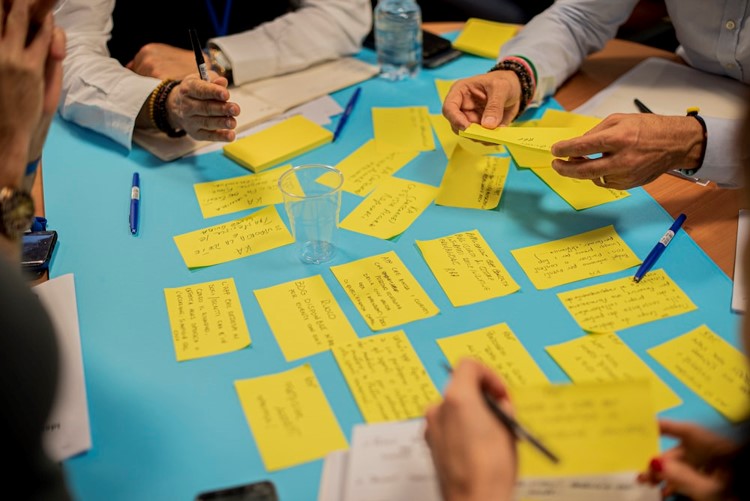today’s post is by Becca Lehner
Over the past 15 years, I’ve designed conferences, workshops, and mini-sessions with as many as a few hundred people to as few as a small team. Whether in-person, virtual, or hybrid, and no matter which collection of tools and techniques I’ve used as a facilitator, it’s all about the process. Our role as designer/facilitators is to create an environment where individuals of diverse backgrounds can come together to think deeply about a problem and explore possibilities. This process must always begin with “connection before content” (Block, 2009).
Connection Before Content
Connection exercises serve to humanize those in the room that will become partners in exploration. Often, folks may feel that they are too frou-frou or take up too much time; they request to skip the connection exercise in favor of jumping straight to task. This is a huge mistake. Each time a connection exercise is skipped or glossed over, an opportunity is missed for participants to get comfortable in the physical space and with each other, effectively stunting conversation. The environment is left feeling buttoned up and awkward vs. open and ready to bring forth new possibilities.
An example of a quick and easy connection activity is “Paper Mingle” where participants rotate around the room in pairs introducing themselves and asking each other a blend of randomly generated questions focused on work and life topics. Participants then consider what choices they made during the activity — did they dive right in or were they initially hesitant — and how might that serve as a view into how they may show up in a similar or different way during they day’s session.
Selecting and Blending Tools/Methods
Once connection has occurred, we’ve come to the heart of a session — a time for discovery and convergence. As a facilitator, the most important step to take with any sponsor when designing a session is to first understand the desired outcome of both the effort overall and the session itself. It is important to listen closely to what the sponsor explicitly asks for along with what may be implied political or symbolic objectives. From here, a MITRE Innovation Toolkit (ITK) tool and/or other methods are selected to shape the day. The tool/method becomes a powerful starting point, though not the end-all-be-all. Let’s take the ITK tools as an example. This set of tools lays a strong foundation for discovering a problem space, ideating, and prioritizing — the questions are carefully curated and could be used as is. However, as a seasoned designer/facilitator, I frequently customize tools to fit a sponsor’s unique situation at a given moment based on what a sponsor is looking to achieve.
For example, a number of months ago over 75 agency senior leaders came together for a full-day, hybrid session to explore methods for increasing trust and collaboration throughout the organization and ways to enhance data equity and services to the public. After a morning focused on increasing psychological safety within and across teams, we spent the afternoon leveraging a host of ITK tools, including the Stakeholder Identification Canvas and the Quickstart Stakeholder Canvas. We leveraged each tool as a foundation for discussion and customized the tools, adjusting the language to fit the agency’s culture and leadership expectations. Leaders grappled with challenging questions brought forth by the tools and ended the day with a greater understanding of what may be important to a given stakeholder group, assumptions and biases that must be accounted for when developing new products and services, and small action steps to advance data equity across populations.
When designing and facilitating, it’s important to remember that success isn’t determined by the tool itself – the tool is a mechanism within a supportive process which increases the likelihood of breakthrough, collaborative thinking.
Attend to the End
It can often be challenging to wrangle participants away from their generative conversations to come to a close. However, a session should never be left hanging in the wind. Attending to the end is a time for selecting a few immediate actions, asking for volunteers/making assignments, and evaluating how the session went to inform future collaborative engagements. A favorite of both facilitators and participants is to close a session with a quick “plus/delta” of what worked and didn’t work throughout the session (whether the answer is an activity adjustment or something as simple as “we need more snacks”) followed by a quick, one-word checkout of how participants are leaving the day. Just as it is important to open the process with connection, so too is it important to exit the process with a feeling of closure and readiness for the activities ahead (Axelrod, 2010).
As designers and facilitators, may we all seek to create supportive environments and a process to foster collaboration, generate thoughtful insights, and connect people to each other and the task ahead in new ways.
Reference
Block, P. (2009). Community: The Structure of Belonging. Berrett-Koehler, Incorporated.
Axelrod, R. (2010). Terms of Engagement: Changing the Way We Change Organizations. Berrett-Koehler, Incorporated.

